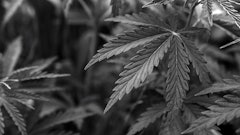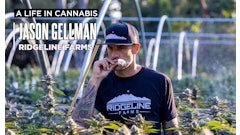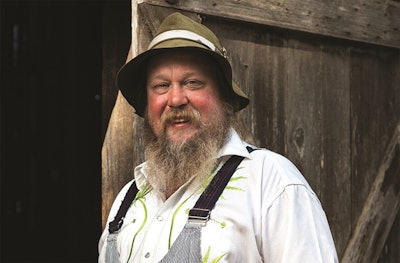
According to the February 2018 report by the California Growers Association, “An Emerging Crisis: Barriers to Entry in California Cannabis,” growers should calculate water use at “one gallon per pound of finished flower per irrigated day.” Consider that California produced 13.5 million pounds of marijuana in 2017 (according to the state Department of Food and Agriculture), and you’re looking at a huge water demand in a state that doesn’t have much to spare. But these numbers don’t affect grower Ty Johnson’s day-to-day operations—because he doesn’t give his plants any water at all. They rely on their natural environment.
Johnson is founder and chief cannabis officer of Eel River Organics in Humboldt County, Calif. Due to the farm’s unique geography, Eel River Organics can afford to participate in dry farming, or farming without added water or an irrigation system. Seeing as cannabis is a water-holic, Cannabis Business Times spoke with Johnson to learn about the processes and challenges of dry farming, how the unique microclimate aids in cultivation, why Johnson doesn’t need to use pesticides or herbicides, and how the four-acre farm's owner chooses which strains to cultivate.
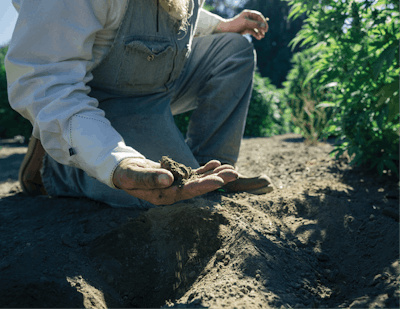
Scott Guthrie: What is dry farming, and how does it benefit the plants?
Ty Johnson: Dry farming is the opposite of normal farming. Traditional farming is where you are watering nutrients from the top down to your plants.
What we have, though, is a huge aquifer that’s running under us, which is the Eel River. The whole Eel River system down below the ground is flowing underneath our farm. We have a deep deposit of silts and sands making this loamy, perfect-textured soil that actually acts like a wick, or sort of a sponge, where it pulls the moisture and the water from down below in the ground up to the surface. The best description would be if you had a wet carpet and you laid a dry paper towel on it, and the towel pulls that moisture to it. That’s how the water and nutrients are getting to the plants.
We have what we call a dry mulch layer on the surface. It has a significant amount of organic matter that hasn’t been decomposed. It’s a dry layer on top of the soil. This dry layer is causing a capillary exchange, where it’s pulling in not only the moisture—but there’s an oxygen exchange, too. In other words, we are in a unique position because we have over 30-feet deep of this perfect sand-silt mixture.
There are multiple things that play into how dry farming is able to work. We have the Eel River and the whole aquifer that’s flowing beneath us. I believe this method produces some of the finest cannabis in the world, because the roots can go as far as they want—15-foot to 20-foot roots are no problem. Watered plants, you’ll notice, will have a root system that is shaped depending on how the water goes into the medium, and it’s this bulbous structure.
We do everything from seeds, so we have this huge taproot (a dominant central root from which other roots sprout). With dry farming, the roots spread out immensely, even when the plants are just a foot or two tall.
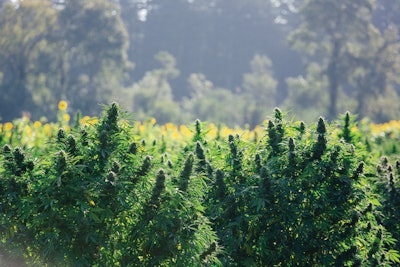
Guthrie: Why do the plants respond so well to the microclimate of Eel River?
Johnson: In other bends here in Humboldt County, there isn’t much farmland left; it’s all been developed into towns. There really isn’t any flat, agricultural land. So, it’s interesting, because while we are a huge, huge county, there is very little farmable land. But Eel River is kind of protected from the coast.
Cape Mendocino sticks out and acts as a barrier to protect against the southerly weather systems coming in. It pushes and curls storms out around the King Mountain Range. Then we are also nestled between a couple rivers that flow on either side of us, and we are also between these little mountains. So, our location has coastal influence, but we are slightly inland enough to get the heat, so we have this Mediterranean climate here.
That’s why our farm is so conducive to the dry farming—because you don’t want it too cold or too hot. You have to have that little breeze. If it is too cold, the moisture won’t come up to the top, and it just sits. But if it’s too hot, that causes problems, too. So, we are in a unique spot for all those things to come together.
Guthrie: Why is the Eel River soil so ideal for cannabis cultivation?
Johnson: It has the heaviest sediment flow of all the rivers around here. We have some of the biggest trees on Earth and some of the biggest king salmon, and when all that is decomposed, you have 30 feet of that in which you’re growing your plants.
Guthrie: Was dry farming a result of the current water shortage in California, or was it a practice you’d been using for a while and that lends itself well to your location?
Johnson: The water shortage doesn’t affect us because we don’t use any. So, it was just a practice I was used to, and it’s what’s best for our location.
Dry farming, compared to not dry farming, is like night and day. Our plants are getting their nutrients through their roots that are down in the ground with silt made up of the mountains and the salmon, etc., that’s tens of thousands of years old. It’s the complete opposite of how most people are watering. You’re getting the nectar of the earth.
Guthrie: Why do you feel more cultivation facilities don’t implement dry farming?
Johnson: Really, you can’t recreate this because it’s such a unique situation.
There are other forms of dry farming that other people do. Vineyards have done it, but they’re relying on the fixed water in their soil structure, where we aren’t using the fixed-water structure. It’s challenging. Agriculture is one of the most destructive things out there. It’s really polluted and messed up a lot of things.
The way that we’re doing it is just being stewards of the land. We’re farming the dirt. We’re farming the soil. We grow all these different forms of legumes and plants that attract different micro-diversity, everything from all the little bugs and bacteria. By growing these cover crops, it’s a form of what some people call green manure. That’s our compost and our organic matter.
But it’s interesting, even in places where you can dry farm, a lot of people don’t. They don’t take that leap because they’re used to planting something and seeing instant results. They want to put it in the dirt and water it, and they want to see results so badly that they’re over-feeding and over-watering.
More people could really benefit from cutting back on their water usage.
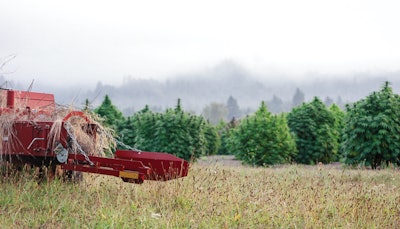
Guthrie: What is the biggest challenge when it comes to dry farming?
Johnson: It’s all a dance, but really, timing and Mother Nature are the hardest parts. Working the soil and getting it to the right consistency to where it will wick the moisture up requires timing. It’s quite intuitional.
When we plant, all we do is one stab with a little post-hole digger, set the seed in there, tuck it in and just lightly cover it with some of the dry mulch. You don’t water again. You’re not feeding it again. You’re not doing anything again. All your work went into just that moment.
You then hope that the rains don’t come and create a big dirt clod, or that it’s too cold. We do a lot of what you call hula-hoeing. When you work the soil through the hula-hoe, it fluffs it and incorporates that dry top crust—the dry mulch—back into that moisture or layer down below, and it pulls the moisture up again.
Guthrie: Without using pesticides or herbicides, how do you ensure your plants stay pest and disease free?
Johnson: Most pests are drawn to the water source. Just by having a water source, things are going to be attracted to it. As we’re dry farming in the river valley, we’re having this strong, steady breeze that comes through, and with our dry mulch on top, there isn’t the bug and pest habitat, really. If you put a pot out in the middle of somewhere and you watered it, it would attract pests, and you’d put in all these organic amendments. We’re not feeding from the top and creating that habitat.
We’re out in the middle of prime agriculture land, not tucked in next to other places that have that habitat. So, it’s dry, and they’re strong plants.
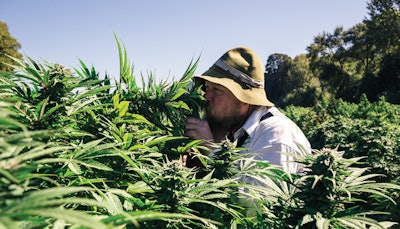
Guthrie: How does Eel River select strains to cultivate?
Johnson: We look for what works and what pops up, what speaks out. It’s taken a long time to develop our strains, and that’s what’s been unique. It’s a multi-generational system that’s gotten us here. It isn’t like we’re doing genetic testing or doing everything for a specific end result.
It’s not a mono-crop. Each plant is its own. They all have their individual phenotype characteristics. We started out with a lot of experimenting, but over time, we’ve come back around, and we still just have these solid hybrids that I’ve been working with.
We do whole plants and seeds, too. But it’s a lot of work, and you’re not getting that instant gratification that you get with mono-cropping where you know it’s the female; you know exactly what it’s going to do. And you can’t dry-farm clones in the same way. They don’t have a taproot. So, with mono-cropping, you’re not getting the taproot that’s feeding, and that’s where seeds are the key to what we do.
Guthrie: You have livestock on the farm. Does the livestock serve a purpose in terms of the cannabis cultivation?
Johnson: On any farm, diversity is key, and the livestock helps with that. We continue to expand our livestock. They play a role in some of our key cultivation preparations. For example, we would use manure in our soil preparations and in some of the other seed-starting. We’re mixing and making our compost with that manure.
For a whole functioning farm, it takes all the diversity of all the different animals. And we’ve experimented with many different things, and there are many ways you can use livestock. For example, you could have your pigs come through and clear out the sticker bush and all the roots. They are root eaters; they’re like rototillers and they’ll just clear right around all the big trees. Then you can have the chickens come behind, and they’ll level it out and eat all the weed seeds. You can move goats around and have them clear brush. I don’t use goats, though. We use the pigs and the chickens and the cows. Goats are another dance, but the huge animals, they rototill and aerate the soil. Plus, it’s great for the diversity of the farm.
Guthrie: How has growing fruits and vegetables on the farm helped with cannabis cultivation?
Johnson: Everything is fun to plant. When you have your hands in the dirt more, it’s better. When you’re cultivating all of these different plants, you come across all types of different situations. Every plant you grow—every fruit, every vegetable—has its challenges, and handling those different challenges can help you problem-solve when it comes to cannabis, and just make you a better farmer in general.
It’s hard work growing all these different plants, but when you start seeing the results of your efforts, it’s worth it. To eat your own food that you’ve grown is interesting stuff. A lot of people I’m around on the farm didn’t necessarily grow up doing it, so to be able to share in that aspect is also cool.
















